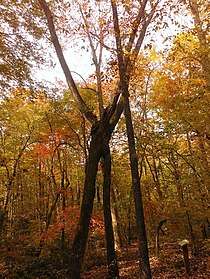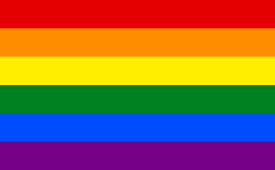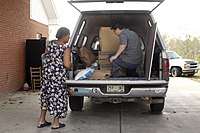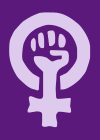Womyn's land

| Part of a series on |
| Lesbian, gay, bisexual, and transgender (LGBT) people |
|---|
 |
|
|
| Sociology |
|---|
.svg.png) |
| Main theories |
| Methods |
| Subfields and other major theories |
|
| Browse |
|
Womyn's land (also called lesbian land,[1] wimmin's land, landdyke communities, or women's land[2]) is a term which refers to intentional communities organized by women to empower women.[2][3] These communities mainly exist in rural areas where land is utilized to establish counter-cultural, women-centered space, often without the presence of males.[2] The first known women's land community in the US was the Sanctificationists, later known as the Woman's Commonwealth, which was established in Texas in the late 1870s to 1880s.[4] In the 1970s, women's land-based communities that explicitly welcomed lesbians were established in the US, Australia, New Zealand, and western Europe.[1] Many still exist today.[5] Womyn's land-based communities and residents are loosely networked through social media; print publications such as newsletters; Maize: A Lesbian Country Magazine;[6][7] Lesbian Natural Resources, a not-for-profit organization that offers grants and resources; and regional and local gatherings to form a social movement variously called the lesbian land movement, womyn's land movement, and/or landdyke movement.[8]
Some womyn's lands practice lesbian separatism, an idea which emerged as a result of the Radical Feminist movement in the late 1960s.[9] Lesbian separatism is based on the idea that women must exist separately from men, socially and politically, in order to achieve a true feminist or lesbian utopia.[10] The radical feminist group Cell 16 is often credited for establishing the base of ideas that define lesbian separatism.[9] These separatist communities exist as a way for women to achieve female liberation by separating themselves from mainstream patriarchal society.[10] Men are not allowed to live in, or enter these communities.[5] Some communities ban male infants and/or male relatives.[5]
Womyn's lands, as well as lesbian separatism, have generated a wide range of criticisms. These criticism center around, but are not limited to, the lack of acceptance by many residents of bisexual and heterosexual women; the exclusion of transgender and transsexual women for not being biological females;[11][5] ideological conflicts with local communities that include violence and threats of violence targeting residents of womyn's land;[12][13] and local community concerns about social change, e.g. rising divorce rates[14] and expanded lesbian visibility.[12][15] Examples of present-day womyn's lands include Hawk Hill Community Land Trust, HOWL, Susan B. Anthony Memorial Unrest Home (SUBAMUH) and Sugar Loaf Women's Village.[16] Today, these communities are facing decline as the founders age, as well as the struggle to connect with younger generations of women.[5]
Background history
Sanctificationists a.k.a. Woman's Commonwealth
Founded in the late 1870s to early 1880s, the Sanctificationists, later known as the Woman's Commonwealth, were a women's land-based commune first established in Belton, Texas.[4] The community was originally established by Martha McWhirter and her women's bible study group on land that was inherited when the women's husbands died or quit the home. Residents of the commune were women and their dependent children; many of the women fled abusive homes to join the community. The Sisters embraced first wave feminist ideologies, and sought spiritual, economic, and social equality for women.[17] To that end, they practiced celibacy as a way to liberate women from the spiritual degradation of heterosexual intercourse, the oppressive needs of children and child rearing, and male violence.[17] The Sanctificationists were economically successful; they ran several boarding houses, two hotels, formed holding companies to manage their properties, and operated two farms to provide food for their multiple dining rooms. At one point, there were between 42 and 50 women members on record,[17][4] including at least one African American woman who is thought to be a former slave.[4] In 1899, the entire commune moved to Washington, DC where they opened boarding houses, a hotel, and participated in urban feminist organizations.[17][14] McWhirter died in 1904, and the commune began a slow decline. In 1917, there were six remaining members who purchased a farm in rural Maryland to provide food for their urban dining halls, and to provide a pastoral retreat for themselves in a rural landscape. The last member of the commune died in 1983 at the age of 101.[14]
A brief article published in the lesbian separatist periodical, Austindyke (alternately spelled as Austin Dyke), in 1979 and then reprinted in Sisters United in 1980 described the Woman's Commonwealth as a forerunner of the lesbian land movement.[18] It is unclear whether the Sanctificationists influenced the movement that flourished in the 1970s and 1980s.[19]
Radical feminism
Radical feminism advocates for the elimination of female oppression through a call towards social and political transformation of patriarchal society.[20] Radical feminism grew out of other radical movements during the 1960s such as the Anti-War Movement.[20] Women who took part in these radical movements felt under-represented in comparison to the men, which contributed to the formation of second-wave feminism and radical feminism.[20]
Radical feminist ideology is different from mainstream or liberal feminism because it believes that women's liberation can only be achieved through the re-ordering of patriarchal society, while mainstream/liberal feminism seeks equality within the current system in place.[21] Radical feminism also focuses on sex as the root of female oppression, as opposed to social class and/or race.[21] Notable radical feminist groups and organizations include Cell 16, Redstockings, The Radical Feminists #28 and The Furies Collective.[22][9][23][10]
Lesbian separatism and separatist spaces
Lesbian separatism is rooted in the idea that women should and must exist separately from men in order to achieve a true feminist utopia.[10] Lesbian separatist ideology has changed over time as the Radical Feminist Movement continued in its development. In the earlier stages of lesbian separatism the term "lesbian separatist" was considered synonymous to the term "radical feminist".[10] However, as each group developed distinct ideologies, tension formed between radical feminists and lesbian separatists.[10] Lesbian separatists used the separatist ideology as a way to "test one's feminist commitment",[10] which resulted in a divide.
An increase in lesbian feminism essays and papers centered around the subject of lesbian separatism, influenced and shaped lesbian separatist ideology as well.[10] Influential works which helped shape lesbian separatism included Lesbian Separatism: Amazon Analysis, the Collective Lesbian International Terrorists Papers, and Cell 16's No More Fun and Games: A Journal of Female Liberation.[24][10]
Lesbian separatism is not only practiced and utilized in communal areas such as womyn's lands; it is also practiced in separatist events and women-only spaces. One example of a feminist separatist event (the invited participants were womyn-born-womyn, girls of all ages, boys 10 and under) is the Michigan Womyn's Music Festival.[11] This music festival was held in Michigan every year from 1976 to 2015.[25] It was created by women for the purpose of establishing an annual safe, social space dedicated for lesbians and females alike.[25][11] The Michigan Womyn's Music Festival embraced a separatist ideology by not permitting men, male children, or transgender women to participate in the festival.[11]
Significance to feminist thought and woman-based communities
Feminist ideology maintains that the patriarchal institutions and social norms which make up society are the source of female oppression.[26] Lesbian separatist ideology recognizes the oppression which results from patriarchal society, however, it asserts that the root of oppression derives from men themselves, individually and as a group.[26] Unlike feminism, lesbian separatism views men as the main source of their oppression.[27] Through this ideology, many lesbian separatists consider men as the sole perpetrators of adverse economic, societal, and cultural issues which affect them.[26] As a result, lesbian separatists sought to construct autonomous Womyn's land communities where they could live segregated from men entirely.[26]
Criticisms
Womyn's land communities have been targeted for criticism. In the 1880s, the citizens of Belton, Texas blamed the Sanctificationists (also known as the Woman's Commonwealth) for rising separation and divorce rates, and of undermining the meaning of marriage through their practice of celibacy.[14][28]

In 1993, residents of Camp Sister Spirit, located in rural Ovett, Mississippi, were criticized by local community leaders including Southern Baptist ministers, Jones County Deputy Sheriff Myron Holifield, and US Representative Michael Parker, who held well-attended town hall meetings and a fundraiser to raise money to force the camp to close.[12][13] The Reverend John S. Allen, who was a pastor in Richton, a town close to Ovett, preached and wrote against Camp Sister Spirit citing biblical concerns about homosexuality.[12][15][29] Residents of the land received bomb threats, hate mail, vandalism, death threats by phone, and other acts of terrorism.[30][13][15] Local law enforcement officials downplayed the threats against Camp Sister Spirit and failed to adequately investigate.[12] In 1994, then Attorney General Janet Reno asked the Federal Bureau of Investigation (FBI) to investigate the potential for violence against Camp Sister Spirit, and later sent federal mediators to attempt resolution.[12][13][15] The opponents of Camp Sister Spirit refused to participate in mediation; a group filed one lawsuit against Reno, and another against Camp Sister Spirit.[12] The conflict also appeared on talk shows and in a Congressional hearing with both sides arguing their different views.[12][15]
Lesbian separatist communities have been criticized for exclusionary policies towards transgender, transsexual, bisexual, and heterosexual women.[11][5] Usually, homosexual females are the only persons permitted to be a member of these communities.[5] Some womyn's lands have also been criticized for excluding women of color and working class lesbians.[31] In the past, lesbian separatist communities were also accused of being a privilege offered solely to the few who could afford the closed-off lifestyle.[31]
The Michigan Womyn's Music Festival was an annual women's music festival held on privately-owned womyn's land near Hart, Michigan, that ran from 1976 through 2015.[32][33] Controversy over the festival's principle that only womyn-born-womyn could participate began in 1991 and continued until the final gathering.[34] Critics of MichFest included actress/comedian Lea DeLaria, music performers the Indigo Girls, poet Andrea Gibson, trans activist/comedian Red Durkin; and musicians Antigone Rising.[35][32]
Present-day womyn's land communities
- Alapine[5]
- Cabbage Lane Land Trust[36]
- Camp Sister Spirit[5]
- Daughters of the Earth/DOE[37]
- Hawk Hill Community Land Trust[16]
- HOWL[16]
- New Mexico Women's Retreat[38]
- Oregon Women's Land Trust
- Ozark Land Holding Association/OLHA[39]
- Sugar Loaf Women's Village[16]
- SuperShe Island[40][41]
- Susan B. Anthony Memorial Unrest Home[42]
- We'moon Land[43]
- WomanShare[44]
Novels about womyn's lands
Several novels have been published in English that have plots centering on womyn's land or female separatist communities[45] (see Single-gender world). These include:
- Daughters of a Coral Dawn by Katherine D. Forrest.[46]
- The Demeter Flower by Rochelle Singer (a.k.a. Shelley Singer).[47]
- Herland by Charlotte Perkins Gilman.[48]
See also
References
- 1 2 Cheney, Joyce, ed. (1985). Lesbian Land. Word Weavers. ISBN 978-0961560508.
- 1 2 3 Levy, Ariel (March 2, 2009). "Lesbian Nation". The New Yorker. Retrieved April 26, 2017.
- ↑ Ellison, Kate (September 30, 2013). "Lesbian Intentional Community: "Yer not from around here, are ya?"". Fellowship for Intentional Community. Retrieved 7 June 2018.
- 1 2 3 4 Lufburrow, Debra (2001). Set Apart: The Sanctified Sisters. Booklocker.com. ISBN 978-1929072712.
- 1 2 3 4 5 6 7 8 9 Kershaw, Sarah (January 30, 2009). "My Sister's Keeper". The New York Times. Retrieved April 27, 2017.
- ↑ "Maize, A Lesbian Country Magazine". Woman, Earth & Spirit, Inc. Retrieved 7 June 2018.
- ↑ "Maize". Retrieved 13 June 2018 – via Lesbian Poetry Archive.
- ↑ Waldner, Lisa K.; Dobratz, Betty A.; Buzzell, Tim, eds. (2004). "Rivers of ideas, participants, and praxis: the benefits and challenges of confluence in the Landdyke movement (by Sine Anahita)". Politics of Change: Sexuality, Gender and Aging (Research in Political Sociology, Volume 13). Emerald Group Publishing. pp. 13–46. ISBN 978-0762309917.
- 1 2 3 Bess, Gabby (October 13, 2015). "No Man's Land: How to Build a Feminist Utopia". Broadly. Retrieved April 26, 2017.
- 1 2 3 4 5 6 7 8 9 Shugar, Dana R. (1995). Separatism and Women's Community. University of Nebraska Press. pp. xi-13. ISBN 978-0803242449.
- 1 2 3 4 5 Browne, Kath (October 2009). "Womyn's Separatist Spaces: Rethinking Spaces of Difference and Exclusion". Transactions of the Institute of British Geographers. John Wiley & Sons. 34 (4): 541–556. ISSN 0020-2754. JSTOR 40270736.
- 1 2 3 4 5 6 7 8 Lynch, Thomas P. (Winter 1995). "Camp Sister Spirit: A retreat under siege". Mediation Quarterly. 13 (2): 151–163. ISSN 1536-5581.
- 1 2 3 4 "Reno Sends Mediators To Mississippi As Lesbian-Run Camp Divides Town". The Washington Post. February 19, 1994. Retrieved 7 June 2018.
- 1 2 3 4 Sokolow, Jayme A.; Lamanna, Mary Ann (April 1984). "Women and Utopia: The Woman's Commonwealth of Belton, Texas". The Southwestern Historical Quarterly. Texas State Historical Association. 87 (4): 371–392. JSTOR 30236969. OCLC 01766223.
- 1 2 3 4 5 Greene, Kate (2003). "Fear and Loathing in Mississippi: The Attack on Camp Sister Spirit". Journal of Lesbian Studies. 7 (2): 85–106. ISSN 1089-4160.
- 1 2 3 4 Conti, Allie (December 18, 2016). "Who's Killing the Women's Land Movement?". Vice. Retrieved April 27, 2017.
- 1 2 3 4 Kitch, Sally (Spring 1994). "The Woman's Commonwealth: Celibacy and Women's Rights". Communities. Fellowship for Intentional Community (82): 40–44.
- ↑ Peticolas, Anne. (1980). "Reclaiming hystory: The Belton Sanctificationists." Sisters United 20(6): 13.
- ↑ Anahita, Sine (2009). "Nestled into Niches: Prefigurative Communities on Lesbian Land". Journal of Homosexuality. Routledge. 56 (6): 719–737. ISSN 0091-8369.
- 1 2 3 Lewis, Jone Johnson (June 6, 2005). "What Is Radical Feminism?". ThoughtCo. Retrieved April 27, 2017. (Updated August 15, 2017)
- 1 2 Echols, Alice (1989). Daring To Be Bad: Radical Feminism in America 1967-1975. University of Minnesota Press. pp. 6–7. ISBN 978-0816617869.
- ↑ Napikoski, Linda (December 30, 2009). "Redstockings Radical Feminist Group". ThoughtCo. Retrieved April 28, 2017. (Updated May 4, 2017)
- ↑ Thomas, June (May 6, 2016). "The National Register of Historic Places Adds Its First Lesbian Landmark". Slate. Retrieved April 28, 2017.
- ↑ Dunbar, Roxanne; Densmore, Dana; Warrior, Betsy, eds. (February 1969). "No More Fun and Games: a Journal of Female Liberation". 1 (2). Cell 16 – via Duke University Libraries. ("No. 1" in Duke Library title is incorrect.)
- 1 2 King, Lori (August 16, 2015). "Womyn's Rite: Annual Michigan Fest roared for 40 years". The Blade. Retrieved June 29, 2017.
- 1 2 3 4 Shugar, Dana R. (1995). Separatism and Women's Community. University of Nebraska Press. p. 42. ISBN 978-0803242449.
- ↑ Frye, Marilyn (1983). ""Some Reflections on Separatism and Power"". Politics of Reality: Essays in Feminist Theory (1st ed.). Crossing Press. ISBN 978-0895940995.
- ↑ Kitch, Sally L. (1992). This Strange Society of Women: Reading the Letters and Lives of the Women's Commonwealth (1st ed.). Ohio State University Press. ISBN 978-0814205792.
- ↑ Allen, John S. (January 6, 1994). "The Homosexual Agenda and the Church: Silence Equals Consent". The Baptist Record. Mississippi Baptist Convention Board.
- ↑ "LGBT History: The Hensons and Camp Sister Spirit". Unity Mississippi. November 16, 2014. Retrieved 7 June 2018.
- 1 2 Shugar, Dana R. (1995). Separatism and Women's Community. University of Nebraska Press. pp. xi-50. ISBN 978-0803242449.
- 1 2 Ring, Trudy (April 21, 2015). "This Year's Michigan Womyn's Music Festival Will Be the Last". The Advocate. Retrieved 10 June 2018.
- ↑ Michigan Womyn's Music Festival (April 21, 2015). "Dear Sisters, Amazon, Festival family". Facebook. Retrieved 18 June 2018.
- ↑ Cogswell, Kelly (April 29, 2015). "Dyke-Baiting, Trans-Hating, and the MichFest Debacle". Gay City News. Retrieved 10 June 2018.
- ↑ Heithmar, Judy (September 10, 2014). "Michfest is dying from bigotry". Socialist Worker. Retrieved 10 June 2018.
- ↑ "Cabbage Lane Land Trust". Facebook. Retrieved 5 February 2018.
- ↑ "Wisconsin Womyn's Land Co-op". History of Gay and Lesbian Life in Wisconsin. 2011.
- ↑ "Lodging & Rates". New Mexico Women's Retreat. Retrieved 5 February 2018.
- ↑ Gass-Pooré, Jordan (31 August 2015). "Lesbian-only 'intentional community' outlasts others". Northwest Arkansas Demorat Gazette. Retrieved 5 February 2018.
- ↑ "SuperShe Island". SuperShe. Spring 2018. Retrieved 4 June 2018.
- ↑ Berger, Sarah (15 April 2018). "After working in a world of 'tech bros,' this woman founded a female-only island". CNBC. NBCUniversal. Retrieved 4 June 2018.
- ↑ "Susan B. Anthony Womyn's Land Trust". SuBAMUH. Retrieved June 29, 2017.
- ↑ "About". We'Moon Land. Retrieved 5 February 2018.
- ↑ Miracle, Billie (Fall 2014). "Local women's land celebrates 40 years" (PDF). Applegater.
- ↑ Shugar, Dana R. (1995). Separatism and Women's Community. University of Nebraska Press. p. 121. ISBN 978-0803242449.
- ↑ Forrest, Katherine V. (1984). Daughters of a Coral Dawn. Bella Books. ISBN 978-1594933042.
- ↑ Singer, Rochelle (1980). The Demeter Flower. St. Martin's Press. ISBN 978-0312191955 – via Goodreads.
- ↑ Gilman, Charlotte Perkins (1915). Herland (1979 ed.). Pantheon Books. ISBN 0-394-50388-0.
Further reading
- Brotman, Barbara (October 23, 1986). "Dictionary For 'Womyn' Says Half Of Society Is A Dirty 3-letter Word". Chicago Tribune.
- Croft, Clare (June 27, 2010). "'Our Hands on Each Other'". Austin American-Statesman.
- Dobkin, Alix; Tatnall, Sally (January 28, 2015). "The Erasure of Lesbians". Gender Identity Watch.
- Enke, A. Finn (2007). Finding the Movement: Sexuality, Contested Space, and Feminist Activism (1st ed.). Duke University Press. ISBN 978-0-8223-4062-1.
- Frank, Priscilla (June 30, 2015). "Look Inside Some Of The Last Remaining All-Female Communes". The Huffington Post.
- Heuchan, Claire (February 22, 2017). "Lezbehonest about Queer Politics Erasing Lesbian Women". Sister Outrider.
- Jeffreys, Sheila (2003). Unpacking Queer Politics: A Lesbian Feminist Perspective (1st ed.). Polity. ISBN 978-0745628370.
- Morris, Bonnie J. (2016). The Disappearing L: Erasure of Lesbian Spaces and Culture (1st ed.). SUNY Press. ISBN 978-1-4384-6177-9.
- OLOC Boston (Old Lesbians Organizing for Change) (2016). "Erasing Lesbians". The Proud Trust.
External links
| Look up womyn's land in Wiktionary, the free dictionary. |
